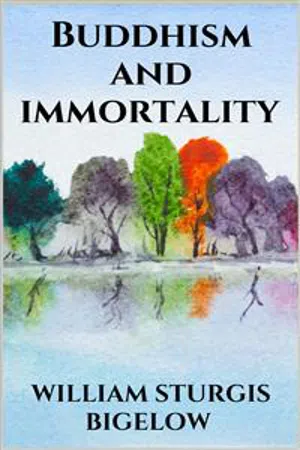![]()
THE BUDDHISM AND IMMORTALITY
The view of the Immortality of Man which I have the privilege of stating is, broadly speaking, that of the Buddhist religion. But Buddhism, like many other great religions, is divided into main churches and subdivided into sects: and we find conspicuously two broad divisions, commonly called Northern and Southern Buddhism, the former having its recognized centre in the north of India, in Nepaul; the latter in Ceylon. The history, the significance, and the relations of these two divisions constitute a vast field of study, into which we cannot attempt to enter to-night.
What I have to say relates primarily to the Northern or Nepaulese Buddhism, and more especially to the doctrines of the two closely allied sects which represent that form of Buddhism in Japan. These sects are known respectively as the Tendai and the Shingon. The whole of Northern Buddhism is closely allied to Brahminism, with which it is historically directly connected. There is a close resemblance in the tenets and doctrines of the two religions, even in their superficial aspects; and the more deeply they are studied, the closer is the connection found to be. The forms of religious service are essentially the same in both; and even in Japan today the greater part of the Shingon and Tendai ritual is not in Japanese but in Sanscrit, and is identical with that which has been in use in India since before the time of Buddha, so long before, in fact, that there is no historic record of its origin, and there is reason to believe that it antedates written history altogether. It certainly appears to be the oldest ritual now in actual use in the world. A similar correspondence between India and Japan is found to hold essentially good in regard to those special presentations or aspects of the great central force of the universe, which are embodied in anthropomorphic forms and recognized as separate deities.
It may be said in passing, that for the understanding of such a vast and intricate system of thought, or even of so small a part of it as we have to consider here, the student handicaps himself with needless difficulties if he begins by classifying it under some such customary heading as Pantheism, Polytheism, Monotheism, Materialism, Idealism, and the like. We all carry in our intellectual pockets a quantity of gummed labels bearing the names of such familiar categories, which we are ready to attach to any new packet of documents, however large, after examining the first one or two, and we then expect to find that all the rest fit exactly into the Procrustean limits that we habitually associate with that particular title. Whereas in the present case the exact contrary is the fact; and we find, on the one hand, that there is ample room to attach almost every label that the mind of man has conceived; and, on the other, that each one is by itself inadequate.
Starting, therefore, without prejudice of any sort, I am going to try to set before you, in such brief outline as the allotted time allows, an epitome or digest of the teaching of these two Buddhist sects, the Tendai and the Shingon, in regard to the special subject to consider which this lectureship has been established, the Immortality of Man. Part of what I have to say is of such elementary simplicity that I almost apologize for saying it, and indeed only do so to be sure that we start together. Part, again, though less simple, is familiar doctrine that may be heard here in the West in any lecture room or from any pulpit. And part, again, lies so remote from our ordinary Occidental habits of thought that I shall hold myself fortunate if I can succeed in making it intelligible.
The generous founder of this annual lecture chose the title well, in assuming the existence of something called man, and restricting the discussion to the question of how long that something lasts. Consciously or unconsciously, we all make the same assumption; for it has been well said that “to doubt our own existence is to call in question the very existence of our doubt.” In this attitude, we have the support alike of the oldest religion and the newest science; for Poincaré, in his latest scientific work, after discussing in detail the theories of force and matter and motion, of electricity and light and ether, sums up the state of the most modern knowledge in these concise words, “Something exists.”
However reckless and extravagant this statement may seem, let us accept it provisionally, and further, for convenience, let us give this something a name. Let us provisionally call it ourselves, you and I, Ito each one of us, and see what are some of the most obvious things to be said about it. What do we mean by it? What did Descartes mean by it when he said: “I think, therefore I am”; and thereby implied the inevitable correlative: “I do not think, therefore I am not”? What is the “I”? What is the “thought”? Are they the same thing or different things? Can either exist without the other?
Let us consider for a moment the ordinary popular view. According to this, man is a compound of a material and tangible part called the body and an immaterial and intangible part called the soul.
The facts abo...
